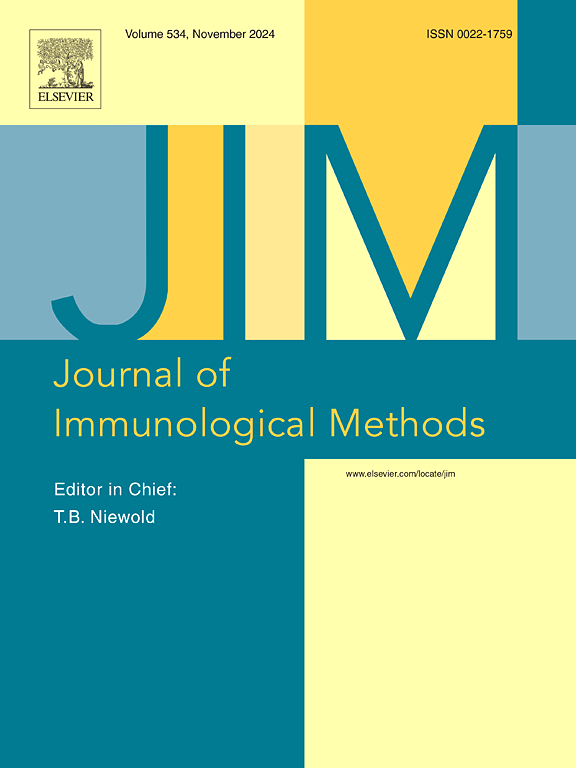Development of multiplexed flow based assay for simultaneous identification and estimation of meningococcal capsular polysaccharide serogroups A, C, W, Y and X for conjugate vaccine manufacturing
IF 1.6
4区 医学
Q4 BIOCHEMICAL RESEARCH METHODS
引用次数: 0
Abstract
The development of a multivalent meningococcal polysaccharide vaccine requires the analysis of active ingredient, i.e., capsular polysaccharides, at various stages of its development. Furthermore, in accordance with WHO guidelines for the release of any batch of purified polysaccharides, it is imperative to determine whether any heterologous polysaccharides, with a threshold of less than 1 % of their dry weight, are present in the sample. We have developed a flow-based multiplexed bead-based competitive inhibition assay (BBCIA), which identifies the meningococcal polysaccharide A, C, Y, W, and X at purified polysaccharides, conjugate bulk, and final vaccines development, and quantified the 1 % heterologous polysaccharides as contaminant in purified polysaccharides. Polysaccharides are coupled to the carboxylated microsphere and incubated with a serogroup-specific antibody-antigen mixture. Unneutralized antibodies bind to respective antigens coupled onto the beads and are expressed in terms of median fluorescence intensity (MFI). The BBCIA identified meningococcal polysaccharides with ≥90 % inhibition during identity, and estimated the heterologous polysaccharides as contaminants with 70–130 % recovery of spiked polysaccharides with a percentage CV < 20 %. Results were validated as per ICH guidelines, such as limit of detection and quantification, linearity, precision, robustness, specificity, and accuracy in accordance to international standards. We are reporting an assay tool that simultaneously identifies and quantifies polysaccharides of the multivalent meningococcal vaccine with the advantages of less time, labour and sample volume in analysis with higher sensitivity and accuracy. With high throughput capabilities and increased sensitivity, BBCIA can be readily adopted to identify and estimate various serogroup-specific antigens for vaccine development.

开发基于多路流动的同时鉴定和估计脑膜炎球菌荚膜多糖血清群A、C、W、Y和X的方法,用于结合疫苗的生产。
研制多价脑膜炎球菌多糖疫苗需要在其研制的不同阶段对活性成分,即荚膜多糖进行分析。此外,根据世卫组织关于任何批次纯化多糖释放的指南,必须确定样品中是否存在阈值小于其干重1% %的异源多糖。我们开发了一种基于流动的多路复合球竞争性抑制试验(BBCIA),该试验在纯化多糖、偶联体和最终疫苗开发时鉴定脑膜炎球菌多糖a、C、Y、W和X,并定量纯化多糖中1 %的异源多糖作为污染物。将多糖偶联到羧化微球上,用血清群特异性抗体-抗原混合物孵育。未中和的抗体结合到相应的抗原偶联到珠上,并以中位荧光强度(MFI)表达。BBCIA在鉴定过程中鉴定出脑膜炎球菌多糖具有≥90 %的抑制作用,并估计异源多糖为污染物,其加标多糖的回收率为70-130 %(百分比CV)
本文章由计算机程序翻译,如有差异,请以英文原文为准。
求助全文
约1分钟内获得全文
求助全文
来源期刊
CiteScore
4.10
自引率
0.00%
发文量
120
审稿时长
3 months
期刊介绍:
The Journal of Immunological Methods is devoted to covering techniques for: (1) Quantitating and detecting antibodies and/or antigens. (2) Purifying immunoglobulins, lymphokines and other molecules of the immune system. (3) Isolating antigens and other substances important in immunological processes. (4) Labelling antigens and antibodies. (5) Localizing antigens and/or antibodies in tissues and cells. (6) Detecting, and fractionating immunocompetent cells. (7) Assaying for cellular immunity. (8) Documenting cell-cell interactions. (9) Initiating immunity and unresponsiveness. (10) Transplanting tissues. (11) Studying items closely related to immunity such as complement, reticuloendothelial system and others. (12) Molecular techniques for studying immune cells and their receptors. (13) Imaging of the immune system. (14) Methods for production or their fragments in eukaryotic and prokaryotic cells.
In addition the journal will publish articles on novel methods for analysing the organization, structure and expression of genes for immunologically important molecules such as immunoglobulins, T cell receptors and accessory molecules involved in antigen recognition, processing and presentation. Submitted full length manuscripts should describe new methods of broad applicability to immunology and not simply the application of an established method to a particular substance - although papers describing such applications may be considered for publication as a short Technical Note. Review articles will also be published by the Journal of Immunological Methods. In general these manuscripts are by solicitation however anyone interested in submitting a review can contact the Reviews Editor and provide an outline of the proposed review.

 求助内容:
求助内容: 应助结果提醒方式:
应助结果提醒方式:


